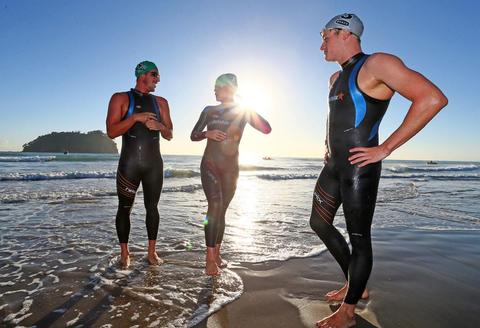Von Collins is an accomplished triathlete and endurance cyclist, and the author of four fitness and training books: Smarter Running, Your First Triathlon Guide, Fit Foods, and 30 Rut-Busting Workouts. He has been cited as a triathlon, cycling, and fitness expert by Healthline, CNET, Forbes, Eat This, Not That and other major outlets.
When it comes to triathlon gear, there are a few age-old either/or questions that get asked constantly, and are continuously open for debate. Tri bike or road bike? Socks or no socks? And when it comes to wetsuit, that question is full-sleeve or sleeveless?
The easy answer is that it depends, but most triathletes who own just one wetsuit go the full-sleeved route. A full-sleeved wetsuit simply means that the wetsuit has two arms that go right down to your wrist, whereas a sleeveless (also called a John or a Long John) cuts off at the should like a tank top. Just because most do this, doesn’t mean that it is the universally correct answer. While there are some advantages to both, the fully sleeved variety of wetsuits offer all of the warmth and buoyancy advantages of a wetsuit for just a few dollars more than the sleeveless type. With that said, we are huge fans of a high-quality, sleeveless wetsuit too.
As is the case with all triathlon clothing, the question is open to debate. The best thing you can do is to be an informed consumer, and we will try to help you do just that below.

Advantages of a Full-Sleeve Wetsuit
- More Buoyancy. As you would suspect, a full-sleeved wetsuit has more warmth and buoyancy for the swimmers. While you arms don’t make up a big part of your bodymass, having them covered by the wetsuit sleeveless does make a slight difference in your buoyancy in the water.
- More Warmth. Not having your arms covered probably won’t makethe difference between hypothermia or not, but leaving them exposed can definitely add a little extra chill in cold water. Most hard core triathletes, though, will tell you that once you get going, your arms won’t feel that cold. It is really the arm circles around your armpits and shoulders that will notice the difference.
- Less Drag. One of the main points of wearing a wetsuit is to replace the drag found on your body with a nearly perfect, form-fitting skin that is completely smooth. When you swim in a full-sleeve wetsuit, you are taking full advantage of the lack of friction afforded by a wetsuit. In some cases on higher-end suits, you will even have wetsuit forearms that assist in getting a better pull on your swim stroke.
- Full Technical Features. Good wetsuits, especially those found in the $300+ price range, use a variety of neoprene thicknesses to create a suit that gives you flex where you want it and warmth where you need it. When you chop off the sleeves, you are also taking away much of the engineering behind a great wetsuit. The materials used on a sleeveless wetsuit don’t have to be quite as precise and high-quality, something that should be reflected in the price.
Advantages of a Sleeveless, or Long John Wetsuit
- Faster transition. Most swimmers who wear a sleeveless wetsuit report a slightly faster T1, to the tune of 5-15 seconds. Not having to get your arms out of a wetsuit makes the process of stripping your wetsuit down to your waist a breeze, and preserves your energy for pulling those legs out of the legholes.
- Less constricting sensation. Most people using a wetsuit for the first time have to get used to the sensation of their shoulders and chest being squeezed in to the suit. While a good-fitting sleeveless wetsuitshould still be snug across the chest, it may lessen the psychological factor of feeling too constricted. We often use a sleeveless wetsuit for just this reason.

The sleeveless wetsuit often provides more shoulder and chest range-of-motion. - Shoulder freedom. Perhaps the main reason some experienced triathletes would choose a sleeveless suit is that it gives better range of motion in the shoulders. Doing your normal swim stroke reach with a full wetsuit can restrict shoulder movement just enough to make them a bit sore, and a poor-quality suit could even cause you to alter your swim stroke. Keep in mind, though, that the wetsuit will still pull down on the base of your neck and inner shoulders, so it isn’t as if there will be no pressure on that region.
- Cooler in warm water. As you would expect, a sleeveless wetsuit will be cooler in warmer water, so if you are to be swimming in water temps of 70 or more, it could be more comfortable than using a full-sleeve wetsuit. The wider armholes will allow your underarms and shoulders to cool your body.
Ultimately, the choice is yours. We personally have one of each in our stable, but then again we are wetsuit junkies and you would expect nothing less. When asked the either/or question, however, we generally suggest people get a full-sleeve wetsuit so they can take advantage of all of the benefits and technology built into them…. But we would be hypocrites if we did not admit that we enjoy a high-quality sleeveless Xterra wetsuit for many of our own races.
The main piece of advice we will leave you with, however, is to buy the highest-quality wetsuit you can afford, and be sure you practice in it several times before race day. Making open water swims, in your actual race day wetsuit, a regular part of your triathlon training plan is critical. And doing so in a nice, higher-end wetsuit will make those early morning swims just a little more bearable.







